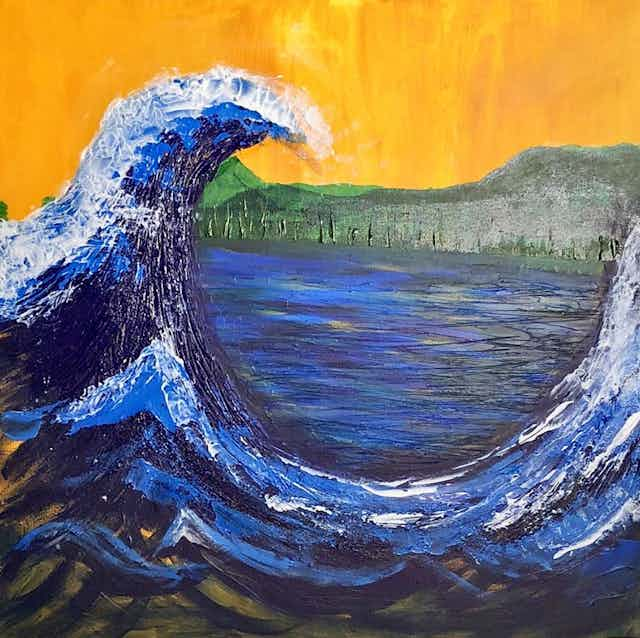The Junction of Politics and Aesthetics in Trump Art
The Junction of Politics and Aesthetics in Trump Art
Blog Article
Exploring the Diverse Globe of Artistic Expression: From Surrealism to Abstract Realistic Look
In the world of creative expression, from the dreamlike landscapes of surrealism to the complex play of light and form in abstract realism, musicians have continuously pushed the boundaries of creativity and imagination. As we check out the diverse globe of art, we are provided with a tapestry of designs, methods, and viewpoints that challenge our understanding and provoke reflection.
Surrealism: Releasing the Subconscious
Surrealism, a progressive artistic motion of the 20th century, delved into the midsts of the subconscious, unveiling a world of dream-like imagery and unconventional associations. Headed by musicians like Salvador Dali, René Magritte, and Joan Miró, Surrealism sought to test the conventional ways of seeing and recognizing art. With techniques such as automatism and desire analysis, Surrealist artists intended to take advantage of the subconscious mind to disclose surprise realities and desires.
Among the crucial elements of Surrealism was the focus on the illogical and the remarkable. By combining unanticipated aspects in their works, Surrealist artists intended to produce a sense of disorientation and surprise in the audience. This disturbance of logic and reason was suggested to prompt a deeper expedition of the subconscious and the secrets of the human psyche.
Abstract Realistic Look: Redefining Understanding
Challenging conventional imaginative borders, Abstract Realistic look redefines assumption through the fusion of identifiable elements with abstract kinds. This innovative technique to art integrates the representational accuracy of realistic look with the imaginative freedom of abstraction, providing visitors a distinct aesthetic experience that motivates them to question their assumption of fact.
In Abstract Realistic look, musicians make every effort to record the significance of their topics while likewise infusing their deal with a sense of deepness and intricacy with abstract elements. By blending the aware of the unfamiliar, these artists invite target markets to engage with their pieces on multiple degrees, motivating them to explore the nuances of structure, shade, and kind.

Cubism: Fragmenting Truth
Making use of fragmented point of views and geometric types, Cubism reinvented the artistic depiction of fact in the very early 20th century. This method not only deconstructed truth but likewise highlighted the flatness of the canvas, paving the means for future abstract art movements.

Cubism can be categorized into 2 major phases: Analytical Cubism, characterized by single shade schemes and detailed, fragmented forms; and Artificial Cubism, which integrated collage components and brighter colors into the make-ups. Via these unique stages, Cubism affected not only painting but also design, design, and sculpture. trump art. Its influence resounded throughout the art world, inspiring artists to check out new methods of analyzing and standing for the world around them
Expressionism: Emotions on Canvas
Discovering the midsts of human emotions through vibrant and meaningful brushstrokes, Expressionism became a profound imaginative movement in the early 20th century. Unlike previous art movements that focused on portraying the external globe, Expressionism looked into the inner world of the musician's subconscious, aiming to stimulate raw feelings and provoke natural actions from visitors.
Expressionist musicians, such as Edvard Munch, Egon Schiele, and Emil Nolde, declined traditional concepts of charm and realistic look for distorting form and shade to convey subjective feelings. Making use of exaggerated brushwork, vibrant shades, and altered numbers assisted create a sense of unease, alienation, or interest in their jobs.
One of the most renowned examples of Expressionism is Munch's "The Scream," which catches the intense anxiety and misery of contemporary life via its swirling, distorted number versus a blood-red sky. With their emotionally billed works, Expressionist artists looked for to test standard creative standards and give a home window right into the turbulent midsts of the human soul.
Contemporary Art: Developing Viewpoints

One of the specifying qualities of contemporary art is its continuous advancement and ability to adapt to transforming cultural landscapes. Musicians are progressively including modern technology into their method, blurring the lines between the electronic and physical worlds. This fusion of tools allows for innovative ways of narration and engaging with audiences in a more interactive way.
Moreover, modern art usually works as a platform for social discourse, attending the original source to pressing problems such as identity, national politics, and the environment. Artists are using their job to prompt and spark vital conversations thought, dropping light on the complexities of the globe we live in. As viewpoints proceed to evolve, modern art stays a dynamic and significant pressure in shaping our social landscape.
Final Thought
To conclude, the world of artistic expression encompasses a wide variety of designs and movements, each with its very own distinct strategy to communicating significance and emotion. From surrealism's expedition of the subconscious to abstract realism's redefining of perception, and from cubism's fragmentation of fact to expressionism's portrayal of feelings, art proceeds to develop and challenge point of views - trump art. Contemporary art mirrors the ever-changing world we live in, offering brand-new ways to analyze and comprehend the intricacies of our fact
As we discover the diverse navigate to this website globe of art, we are offered with a tapestry of designs, techniques, and approaches that challenge our understanding and provoke reflection. Its effect reverberated across the art globe, motivating artists to explore new ways of standing for the world and translating around them.

Report this page